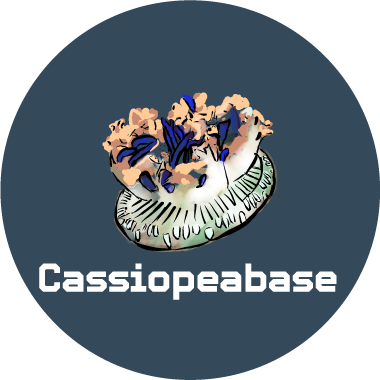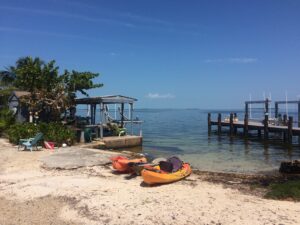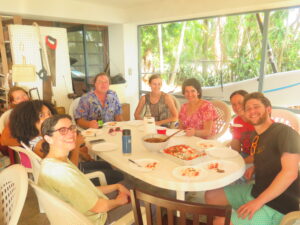The International Cassiopea Workshop is a multidisciplinary effort to bring together researchers already working on the Cassiopea system. Held annually in Key Largo Florida since 2018, one of the many global locations Cassiopea sp. are found, this event is a combination conference and workshop where scientists interested in conducting field research after the research presentations at the conference may stay and work at the Key Largo Marine Station.
6th Annual International Cassiopea Workshop
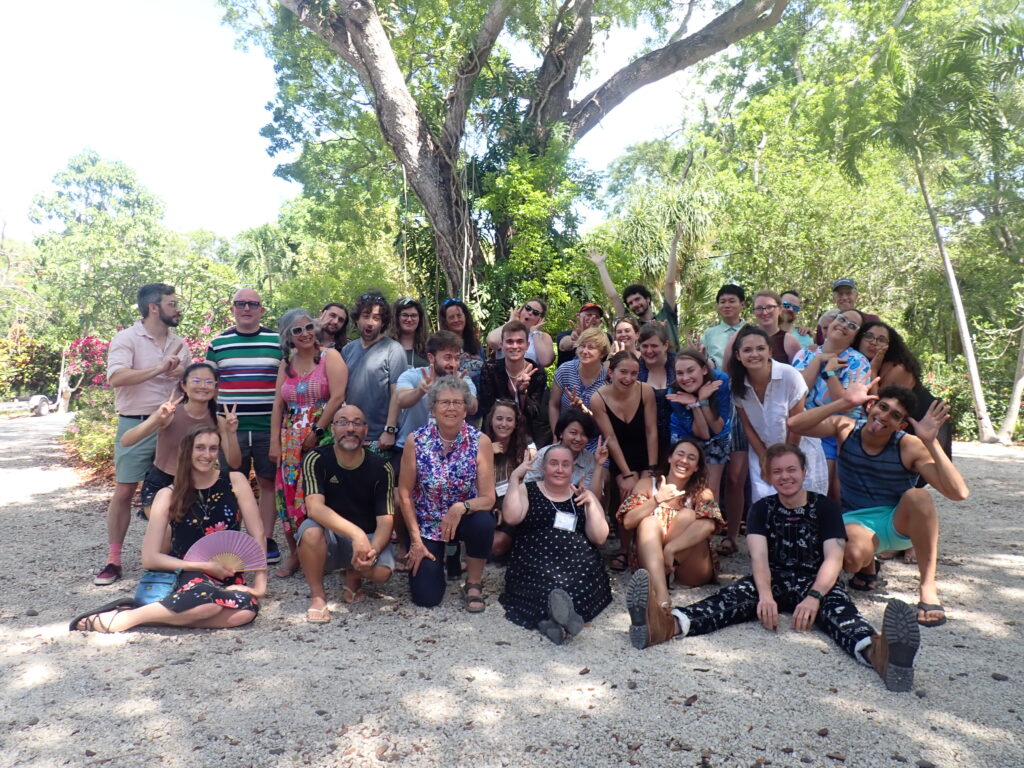
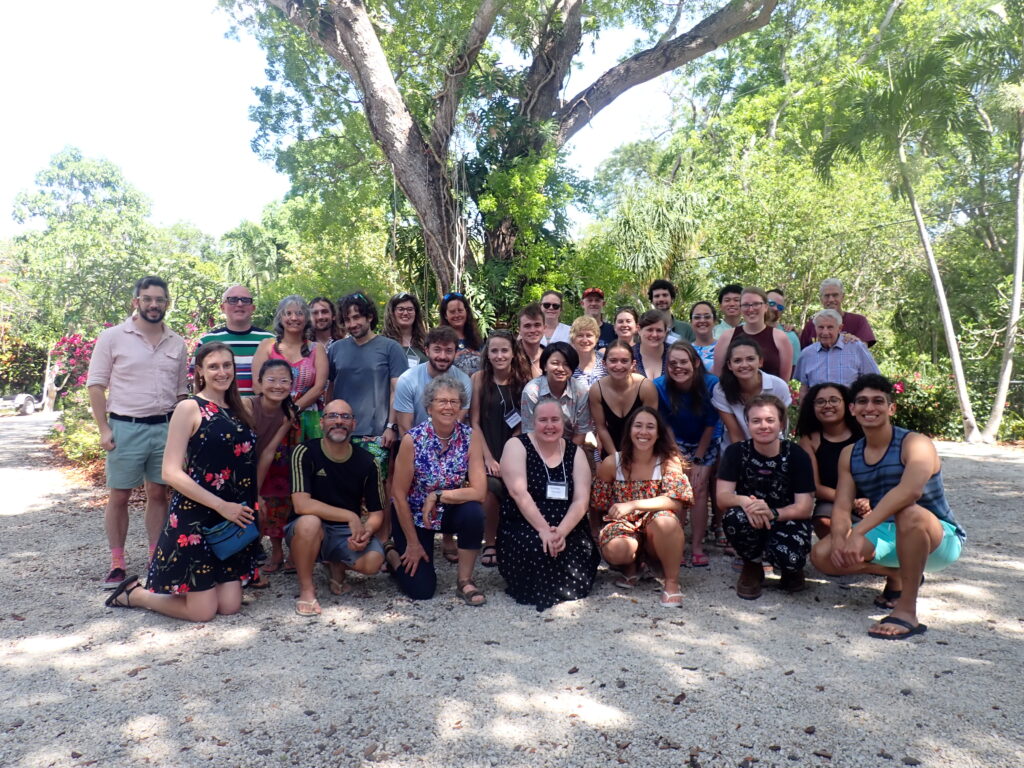

Abstracts
Pam Hallock – University of South Florida
The Hadean and Archaean oceans were far different from those of the modern Earth and those early conditions fostered the emergence of a diverse array of both autotrophic and heterotrophic metabolic pathways in prokaryotic Archaea and Eubacteria. Autotrophic processes require an energy source, a source of dissolved inorganic carbon, a proton source, and essential nutrients. Early microbial forms evolved in aquatic environments lacking free oxygen, but rich in hydrogen sulfide and methane as energy sources for chemoautotrophs and sunlight for photoautotrophs, which utilized Fe2+, H2S, or H2O as proton donors. The latter, oxygenic photosynthesis, released oxygen (O2) as a “waste productâ€, profoundly altering the oceans, the atmosphere, and the evolution of life on Earth. As oxygenic photosynthesis altered sunlit aquatic environments, the subsequent development of oxygen-dependent ATP-generating pathways resulted in more than an order of magnitude energy yield from each organic carbon molecule utilized.
The evolutionary breakthrough, resulting in the symbioses that produced Eukaryota, emerged when anaerobic Protoarchaeota engulfed, but did not digest, α-proteobacteria that had developed oxygen-independent ATP-
generating pathways. Those α-proteobacteria ultimately evolved to become oxygen-dependent mitochondria. As this symbiosis was heterotrophic, a third essential step was establishment of symbioses between early eukaryotes and photosynthetic bacteria, resulting in the eukaryotic algae. Essential to these symbioses was the resistance of the engulfed symbionts to digestion by the host.
Subsequent steps, which occurred many times in Proterozoic and Phanerozoic history, were the development of kleptoplasty and actual algal symbioses. Such “mixotrophic†pathways, that is, the ability to both feed and photosynthesize, can provide the holobiont (host plus photosynthetic symbionts) access to literally orders of magnitude more energy (as fixed carbon) than would be available to a purely heterotrophic organism in the same environment. However, the maintenance and reproduction of two metabolic systems has a variety of costs. Kleptoplastic and facultative mixotrophs can harvest photosynthetic plastids or algae that can provide energetic benefits when food is scarce. Mixotrophic systems that calcify can thrive in environments where dissolved nutrients are very limiting, and calcification can provide both protection and phosphate sequestration. But what are the energetic benefits of mixotrophy to soft-bodied organisms like Cassiopea that thrive in environments where particulate organic carbon is relatively abundant?”
Christina Hamlet – Bucknell University
Though relatively sessile, Cassiopea drive large amounts of fluid around their bells using pulsatile contractions. Nutrient capture, temperature regulation, and waste removal all take place neat the complicated oral arms structure. Depending on the configuration of the oral arms, the flow around the jellyfish may encounter a ‘solid structure’ (plate) or a ‘leaky structure’ (rake). By reconfiguring their arms, Cassiopea can affect whether water is directed through the arms or around it, changing the flow dynamics and the organism’s interaction with its environment. In this talk, I will discuss the computational modeling of these dynamics, some results, and future directions.
David Michael Baker– The University of Hong Kong
Title: Isotopic insights on nutritional symbioses across populations and phylogenies
Understanding the role of diet in shaping the ecology and evolution of species is a steadfast pursuit. Yet, resolving the relative importance of dietary sources in an organisms’ energy and growth budgets is particularly difficult within nutritional symbioses – such as those ubiquitous amongst shallow marine invertebrates (corals, bivalves, jellyfish, sponges) and their microbial symbionts. Increasingly, stable isotope approaches are employed to resolve diet – often as an alternative to exhaustive and potentially misleading examinations of ingestion (e.g. particle removal, substrate depletion, etc.). Here, I will share results from a novel application of Stable Isotope Bayesian Ellipses in R (SIBER) to symbiotic partnerships – from reef building corals, to giant clams. Heterotrophy – as evidenced by little overlap in host and symbiont isotopic niche areas correlates well with large polyp size (corals) and slower growth rates (clams) – whereas autotrophy is linked to an elevated conservation status. Other factors, such as seasonal variation in trophic plasticity, fatty acid and amino acid compound-specific isotope analysis, and how all of this can inform effective management and restoration action will be discussed.
Malte Ostendarp – University of Bremen
The upside-down jellyfish Cassiopea increasingly occurs in many (sub-) tropical coastal habitats such as mangrove forests, seagrass meadows, and coral reefs. Its mixotrophic lifestyle and ecophysiological plasticity as well as a high regenerative capacity may be reasons for its success. While the regeneration of umbrella tissue and body structures (i.e. rhopalia and oral arms) was already demonstrated, it remains unclear whether a fully functioning medusa can regenerate from only umbrella tissue. In this study, we thus investigated the regeneration of umbrella fragments over time. We conducted a laboratory experiment for which we used 18 Cassiopea medusae of three different size classes that were cut into two pieces each, one fragment with oral arms and one without. Over a total observation period of 5 weeks, we regularly monitored survival, pulsation behavior, growth and the regeneration pattern of fragments. Findings revealed that 100% of the fragments with oral arms and 88% of the fragments without oral arms survived. Pulsation behavior occurred in all fragments and lasted until the end of the experiment in 94% of all fragments. The umbrella area of fragments without oral arms showed a significantly higher decrease in the first two weeks compared to fragments with oral arms. A complete regeneration of umbrella tissue was observed in all fragments, with and without oral arms alike, and 50% of all fragments even regenerated rhopalia or oral arms as body structures after 33 days. These results suggest an outstanding regenerative capacity of Cassiopea jellyfish after fragmentation. This may contribute to (i) explain the currently observed success of upside-down jellyfish and (ii) extend our knowledge about its regeneration process, which might even act as an asexual reproduction mode in Cassiopea.
Marta Mammone – Pennsylvania State University
The regenerative capacity of Scyphozoans (Phylum Cnidaria) has been relatively understudied. The model organism Cassiopea xamachana hosts photosynthetic dinoflagellate symbionts in the host’s motile amoebocyte cells. A handful of studies have reported regeneration in the polyps of C. xamachana, but the mechanisms underlying regeneration have not been fully explored. Despite undergoing drastic developmental changes when symbiotic, the effect of symbiont presence and species on host regeneration has never been explored. C. xamachana polyps were decapitated when aposymbiotic, and symbiotic with both a homologous and a heterologous symbiont species. Regeneration and asexual budding were observed, and EdU labeling was performed to observe patterns of cell proliferation in regenerating polyps. The presence of symbionts increased likelihood to regenerate, yet symbiont species did not affect success of regeneration. No blastema or dividing cells were observed, implying cell proliferation is not the primary mechanism behind regeneration in polyps of C. xamachana.
Victoria Sharp– Pennsylvania State University.
Cassiopea xamachana is quickly spreading in popularity as a model organism across the world and many researchers start their lab cultures from scratch. Cassiopea care is unique to other jellyfish and even to coral, and keeping a reproductively-active and healthy population is critical for successful lab work. Here I will give a brief summary on the bare necessities on keeping all life stages of C. xamachana alive.
Kaitlin Kitch- Pennsylvania State University.
Cassiopea xamachana serve as a model organism to study symbiotic interactions between Cnidarians and their mutualistic partners. This study tests the optimal conditions, considering both light and nutrient availability, for Cassiopea xamachana polyp survival and reproduction in a laboratory setting. Six genetically identical polyps were subjected to each treatment. To test the effects of light, six polyps were kept in the dark 24 hours per day and six polyps were kept in the light incubator, where they experienced 12 hours of light and 12 hours of dark per day. To test the effects of nutrients, separate polyps were fed artemia supplemented with Spirulina, Algemac, S presso, and all the nutrients (Spirulina, Algemac, S presso, and Pavlova) in addition to a control plate being fed untreated artemia. Each plate of six polyps was fed one type of artemia three times per week for 31 days. To measure growth, buds were counted three times per week for 31 days for both experiments. For the light experiment, polyps exposed to light produced over eight times as many buds as polyps kept in the dark. In regards to nutrition, polyps supplemented with Algemac produced the most buds, followed by those supplemented with S. presso, polyps supplemented with all nutrients, then polyps supplemented with Spirulina. All treatments produced significantly more buds than the control polyps. Additionally, the polyps undergoing nutritional treatments were exposed to their symbiont after the first phase. For the second phase, the polyps were observed for three weeks, and the date each strobilated was recorded. Contrary to the first experiment, polyps treated with all nutrients strobilated the quickest followed by the control polyps.
Jacob Snyder- Pennsylvania State University.
Most reef-building corals form intracellular mutualisms with dinoflagellate endosymbiont algae in the family Symbiodiniaceae, which fulfill a majority of their energetic budget and partly define their response to environmental change. Warming ocean temperatures disrupt coral-symbiont mutualisms during coral bleaching events, triggering mass mortality in reefs and depriving humans of an economically and ecologically significant resource. This investigation monitors the population growth and photochemical efficiency of five cultured species of Symbiodiniaceae, spanning three genera, under ambient and elevated temperatures to derive thermotolerance ratios. Here, I confirm the thermal tolerance of Symbiodinium microadriaticum and the thermal sensitivity of Symbiodinium tridacnidorum, as established in prior literature; yet, I characterize Durusdinium trenchii as thermally susceptible, challenging its status as an extremophile. Significantly, our results suggest that Breviolum aenigmatum and Breviolum pseudominutum -largely understudied species- exhibit thermal sensitivity and moderate thermal tolerance, respectively. This study provides insight into the within- and between-genera differences in symbionts- susceptibility to heat stress to characterize their potential capacity to confer tolerance to a symbiotic host in the face of environmental change.
Caroline Link – New College of Florida
The coral genus Acropora is a primary reef-building taxon widely found in Florida and throughout the Greater Caribbean
region. Two species in particular, A. cervicornis and A. palmata have been listed as critically endangered and are a main focus of numerous major restoration efforts. Recent studies have found that Symbiodiniaceae species differ in their physiological thermotolerances and determined symbiont identity is likely a key determinant of a coral hostâ€TMs susceptibility to thermal stress. Despite the importance of symbiont identity and thermotolerance in supporting the rapid acclimation of corals to increased temperatures, the specific degrees of thermotolerance both between species and among strains of the same species remain largely unknown. Our understanding of Acroporaâ€TMs primary symbiont species Symbiodinium fitti (type A3) is particularly limited because of the difficulty in establishing and maintaining in vitro cultures. Our project aims to develop a new methodology for culturing S. fitti by establishing in hospite cultures within Cassiopea xamachana polyps instead.
Bailey Steinworth – University of Florida
Though the life cycle of Cassiopea xamachana has been well described, the embryonic stages preceding the planula have not yet been characterized in detail. These early embryonic stages of cnidarians vary in important ways that can help us understand the evolution of body forms across Cnidaria and Metazoa as a whole. Within Medusozoa, the stages leading up to the planula are particularly important for understanding evolution, because the polyp and medusa body forms in many lineages have diverged so much it can be difficult to establish morphological homology. C. xamachana embryos are naturally brooded by the mother until they reach a swimming stage, but can be collected as fertilized zygotes released onto the oral disc region at a consistent time each day, based on the light cycle. Though the exact site and time of fertilization remains unclear, collected zygotes undergo their first cleavage approximately two hours after collection when kept at room temperature (about 25°C), and develop into swimming planula competent to settle and become polyps within six days. Gastrulation occurs between 24 to 48 hours after the first cleavage and appears to proceed by invagination. Between 72 to 96 hours, the blastopore closes and the endoderm and ectoderm become separate layers of cells. At around five to six days old, the planula becomes competent to settle in the presence of a bacterial or chemical cue, though in the presence of antibiotics the planula will remain in the swimming form for extended periods of time. The first morphological changes of settlement occur when the leading.
Cody Miner – University of Florida
Like many other cnidarians, Cassiopea harbors photosynthetic dinoflagellate endosymbionts in the Family Symbiodiniaceae. The relationship in Cassiopea is unique in that some of their symbiotic gastrodermal cells, containing this algae, undergo an epithelial-to-mesenchymal transition and enter the mesoglea matrix. Dissociation of the gastrodermis and epidermis allows for isolation of this mesoglea with its embedded cells, allowing for the separation of two symbiotic cell types within a single species. We have also developed an electroporation protocol that allows for the knockdown of gene targets in asexual buds. This is in pursuit of a larger study to explore the mechanism of this transition through RNA sequencing and subsequent functional validation.
Natalia B. Lopez-Figueroa – University of South Florida
Bioindicators are used to detect environmental changes and provide quantifiable metrics of the health of ecosystems. Recent work with scyphozoans of the genus Cassiopea has revealed their potential as bioindicators in tropical coastal ecosystems, responding to disturbance of sediments and to pollutants. The ecosystems of Jobos Bay NERR (JBNERR) are under constant threat of degradation by anthropogenic activity, sea-level rise and associated hydrological changes. Because migration of these ecosystems is limited by coastal development, implementing effective management-action plans are essential. The focus of this project is to assess the potential of Cassiopea as bioindicators of nutrient pollution and other anthropogenic disturbances in coastal ecosystems. Research goals include to: (1) assess distributions of Cassiopea in the shallow subtidal zone adjacent to JBENRR; (2) compare two methods of assessments using photogrammetry ; and (3) determine percentage coverage of Cassiopea in areas of high, mild and low human development areas. Nine sites have been established in areas of Jobos Bay, three each as high, mild, and low human impact. Each site includes five transects within a 10 x 25 m plot. Videographic surveys are performed two ways: (1) a total recording of each transects and (2) recording 0.25 m2 quadrats every 2 m along the 10 m transect for percentage coverage. Random quadrat tosses are also performed within the plot to compare methods to determine which method provides a better estimate of the population structure. Preliminary data show that Cassiopea populations respond to extreme climatic events such as the passing of Hurricane Fiona when populations migrated from near creek outlets to 3.2 km offshore. This project will further characterize these readily observed organisms as low-cost bioindicators to provide rapid environmental assessment to inform mitigation and restoration practices. The results of this project will. provide a baseline to create long-term jellyfish biomonitoring program in Puerto Rico and perhaps the Caribbean.
Colin Anthony – Tohoku University.
As the internet expands and the globe becomes more connected, science is more accessible than ever. Here, we use rhizostome jellyfish observations from iNaturalist (including Cassiopea) to provide a framework for modeling marine distributions from publicly available data. This type of analysis is highly valuable for predicting currently undescribed populations or future biological invasions. During this demonstration, we revealed heavy ‘Western’ participation bias. Therefore, we recommend initiating collaborations with regional experts, public figures, and hobbyists to begin mitigating participation bias present in iNaturalist data.
Edmee Royen – University of Liege
The symbiotic partnership between cnidarians and dinoflagellates from the family Symbiodiniaceae constitutes the basis of remarkably diverse ecosystems. This tight association between the cnidarian host and the intracellular photosymbionts displays a complex energetic metabolism, involving respiration from both partners and photosynthesis from the dinoflagellate symbionts. Despite the major importance of these two critical processes, their interplay and regulations remain poorly studied. Abiotic factors can unsettle the symbiotic balance, leading to the collapse of the partnership and threatening the survival of entire ecosystems. Among them, the rise in sea water temperature is getting more and more concerning as global warming takes place.
To address this topic, our first approach consisted in subjecting Cassiopea, an established model organism for photosynthetic jellyfish, to a mild hyperthermic stress for 28 days. Despite an increase of 6°C of the water temperature, the stressed jellyfish kept on growing over the experiment, similarly to their control counterparts. In both groups, the symbiont density remained remarkably constant, as opposed to the bleaching that has already been observed in other photosynthetic cnidarians. Along this experiment, several photosynthetic parameters were measured, among which the
relative electron transport rates through both photosystems. No differences could be observed between the two jellyfish populations, and the relationship between the activity of PSII and PSI, measured concurrently, remained linear, indicating
the absence of adjustment related to a circular electron flow in the dinoflagellate. The relative electron transport rate through PSII was also measured simultaneously with the production of dioxygen. Our results also show a linear relationship between these photosynthetic parameters, suggesting the absence of alternative electron flow involving oxygen, such as the Mehler reaction, in stressed jellyfish. The measurement of the level of pigments in Symbiodinium cells hints at an adaptation of the photosynthetic apparatus to heat stress, with the slight increase of the amount of total pigments per cell and the transient rise in the deepoxidation of xanthophylls. A re-organization of the light-harvesting complexes of the dinoflagellate is also suggested by the variation of the relative importance of peaks corresponding to the main antennae on fluorescence spectra measured at 77K. Despite the minor impact of heat stress on the photosynthesis of symbiotic Cassiopea, an increased respiration along with an increase in bell pulsation rate were observed in the heat-stressed population. To dig more into the cellular scale, we are repeating this long-lasting heat stress experiment, collecting samples to carry out bottom-up proteomics analysis. The production of reactive oxygen species is also investigated, along with the fatty acid composition of both symbiotic partners.
All in all, our work aims at taking advantage of the biophysical and spectroscopic techniques in the context of the mutualistic partnership between cnidarians and dinoflagellates, as well as its disruption. Our results show the tolerance of Cassiopea andromeda jellyfish and their dinoflagellate symbionts to a long-lasting hyperthermic stress.
Kaden Muffet – Texas A&M University at Galveston
Photosymbiosis is central to success in many cnidarians. This symbiosis is often influenced by bacterial microbiome of the host organism. While many anthozoans have sequenced natural microbiomes, this data is absent for Cassiopea. Sampling internal and external microbial communities from 34 medusae from across eight Keys in August 2021, we were able to identify that the largest components of the low-diversity Cassiopea-associated community are Endozoicomonas, Vibrio and Mycoplasma.
Madison Emery – University of Texas at Arlington
Many cnidarians form a mutualistic intracellular symbiosis with algae in the family Symbiodiniaceae. In order to establish and maintain intracellular symbiont populations, cnidarian immunity must be suppressed. This likely results in a tradeoff between the nutrition gained from the symbionts and the hostsâ€TM ability to successfully respond to pathogens. We found that in the facultatively symbiotic upside-down jellyfish Cassiopea, symbiotic polyps are more susceptible to the pathogenic bacteria Serratia marcescens relative to their aposymbiotic counterparts. To better understand the mechanisms of this difference in susceptibility, we quantified gene expression of symbiotic and aposymbiotic polyps at 24 hours following exposure to the bacterial pathogen. We found that the master immune regulator NFkB was downregulated in symbiotic control polyps, supporting the hypothesis that symbiotic polyps are immunosuppressed. In response to S. marcescens, both symbiotic states had significant gene ontology enrichments for immune terms in their differentially expressed genes. However, the symbiotic polyps also had enrichments indicative of an unfolded protein response. This suggests that the symbiotic polyps are mounting an immune response that is damaging their proteins and may be more inflammatory.
Vivian Li – Pennsylvania State University
Cnidarians, including Cassiopea, depend on microalgal endosymbionts (Symbiodiniaceae) for resources that support growth, development, reproduction and metabolism. The specificity of host-symbiont relationships in cnidarians seem to suggest that this specificity is driven by very specific nutrient needs (or waste removal needs?) from both sides that have developed over evolutionary time. Examining how microbiomes benefit free-living symbiont cells in culture may tell us more about symbiont physiology and how it behaves in symbiosis with different hosts.
My research examines relationships between Symbiodiniaceae and their bacterial microbiomes, seeking to answer the question of how Symbiodiniaceae microbiomes influence their physiologies from an eco-evolutionary perspective. I am characterizing the microbiomes of 20 Symbiodiniaceae lab cultures spanning a wide range of physiological traits and phylogenetic placement. I will determine the community structure and composition of the microbiomes of each of these cultures using amplicon sequencing of the 16S rRNA gene. I will then investigate the putative metabolic capabilities of key/core microbiome members that may be contributing to distinct host phenotypic characteristics.
By identifying the benefits that Symbiodiniaceae cells are getting from bacteria in free-living cultures, we could perhaps learn more about the nutrient needs (and/or waste removal needs) of Symbiodiniaceae in hospite. Studying Symbiodiniaceae microbiomes thus generates valuable inside in to the health and functioning of cnidarian holobionts, providing new perspectives for conservation in the face of climate change.
Justin Dalrymple – Florida International University
Coral bleaching is the expulsion of intracellular photosymbionts by their coral hosts in response to stress. While bleaching is projected to be a growing problem for the world’s reefs, molecular mechanisms underpinning bleaching remain unclear. We performed a mechanism-agnostic screen to identify underlying candidate pathways in the model symbiotic anthozoan Exaiptasia diaphana. Anemones were exposed to 1,280 human pharmaceuticals for 96 hours before bleaching was assessed by fluorescence. Since pharmaceuticals interact with known targets, this approach represents a novel method for understanding the mechanistic basis of dysbiosis. Preliminary analysis reveals over 70 compounds that cause bleaching in anemones, including medications prescribed for psychiatric disorders, osteoporosis and blood pressure.
Michael Hewitt – Pennsylvania State University
Marine heatwaves associated with climate change and subsequent mass coral-bleachings have prompted decades of increased interest in the vital symbiosis between reef-building corals and mutualistic dinoflagellates in the family Symbiodiniaceae (zooxanthellae). The upside down jellyfish Cassiopea xamachana is a useful model system for studying symbiosis establishment, and competition between their potential symbionts. Previous studies have looked at competition between symbiont species in this system, however, none have looked at competition under heat stress. In some corals, thermotolerant symbionts may be more successful under high heat than their less tolerant counterparts. We ran competition experiments between three symbiont species known to establish symbiosis with C. xamachana; the jellyfish’s homologous symbiont Symbiodinium microadriaticum, and the heterologous symbionts Breviolum minutum, as well as the thermally tolerant Durusdinium trenchii. Each experiment paired species against one another, at different starting concentrations (25:75, 50:50, 75:25). The experiments were run under both control (27 C) and heat-stressed (32 C) conditions. Under control temperatures S. mic. and D. trenchii both competitively displaced B. min., but when competing against one another there was less of a clear winner in either direction. Under heat-stress, the polyps that were given heterologous symbionts did poorly; only two ephyrae established symbiosis and all polyps appeared bleached, however the polyps that were given the homologous symbiont continued strobilating throughout the experiment. Under heat stress, S. mic. dominated both of the other species. These results suggest that partner specificity in C. xamachana is somewhat strong and although the system can harbor heterologous symbionts, these foreign symbionts do not help the animal survive during heat stress even if the symbionts themselves are thermotolerant.
Megan Maloney – Auburn University
Upside-down jellyfish (Cassiopea sp.) are highly tolerant to stresses associated with ever-changing marine environments, particularly extreme temperature changes. This may be due to their ability to modulate rates of bell pulsation, which may promote feeding, oxygen exchange, and symbiont uptake. Additionally, Cassiopea exhibit conspicuous color variation, in both hue and number of colored appendages. To test the capacity of temperature acclimation to influence thermal tolerance on Cassiopea color morphs, adult Cassiopea were acclimated for 30 days to two temperature treatments (26°C or 33°C), and subsequently exposed to acute heat stress. Individuals acclimated at 33°C survived to significantly higher lethal temperatures compared to those acclimated at 26°C. Additionally, Cassiopea with blue appendages survived to significantly higher temperatures and exhibited less change in bell pulsation rates compared to non-blue individuals. These results indicate that Cassiopea can acclimatize to elevated temperatures and suggest that phenotypic plasticity and coloration may play a critical role in survival during heat stress.
Addie Harrison – University of Arizona.
Nematocysts are stinging organelles found in organisms such as jellyfish, anemones, and hydrozoans. The immersed boundary method is used to couple the elastic equations and the fluid equations to numerically simulate nematocyst firing and ejecting dynamics. The model simulates the barb moving with a prescribed motion towards a flexible circle target in two dimensions. In our firing model, we altered parameters for prey size, viscosity of the fluid, and lengths for applying force. Our preliminary results show that the nematocysts ability to accurately hit and puncture a surface it is projected to hit can vary based on the acceleration used to fire as well as the target’s size and makeup.
Christine Wu – National Experimental High School at Hsinchu Science Park, Taiwan.
Based on the publication “Cassiosomes are stinging-cell structures in the mucus of the upside-down jellyfish Cassiopea xamachana” (Cheryl L. Ames et al. 2020), we reported the presence of Cassiosomes in the mucus of the jellyfish Cassiopea andromeda from Taiwan.
Cassiopea andromeda, a type of upside-down jellyfish, often attaches itself to the bottom of water bodies with its bell facing downwards. We observed that Cassiopea andromeda releases mucus in response to water disturbance and the presence of prey. Within the mucus, we confirmed the presence of cassiosomes, which are cell-like structures composed of nematocysts and symbiotic zooxanthellae algae released from the sac-like structures on the jellyfish’s vesicular appendages. Upon contacting Artemia salina, cassiosomes can cause death within 30 (±10) seconds, indicating that they enable Cassiopea andromeda to effectively capture and feed on its prey.
Tan Kei Chloe – Tohoku University
Using DNA molecular barcoding, our primary goals are to uncover the co-evolution of specific Symbiodiniaceae and Rhizostomeae taxa. Targeting mitochondrial 16S rRNA and COI and nuclear ITS gene fragment in oral arms and umbrella tissues of rhizostome jellyfish from aquariums in Japan, combined with available sequence data in GenBank we reconstructed a phylogenetic tree. Next, we followed the same protocol to identify the Symbiodiniaceae hosted by each jellyfish taxon using Symbiodiniaceae genus-level specific ITS2 gene region primers. Both rhizostome and endosymbiont gene targets were amplified with varied difficulty depending on tissue type. Reconstructed phylogenetic trees included our samples from four families and five genera of rhizostome jellyfish and their respective associated Symbiodinieacea at the generic level. During this study we developed a new protocol to target both the symbiont and jellyfish host simultaneously, thereby speeding up validation of the presence or absence of Symbiodiniaceae in rhizostome taxa. Moving forward, using molecular data from this study and additional samples and morphological data from microscopic observation and the literature, we aim to reconstruct the co-evolution of Symbiodiniaceae diversity in Rhizostomeae.
Emily Van Buren – University of Texas at Arlington
Many members of the phylum Cnidaria have independently evolved to host unicellular dinoflagellate Symbiodiniacae. Studies regarding symbiosis often focus on the cellular biology of the cnidarian host during this symbiosis establishment, leaving much to be understood regarding the symbiont’s expression and role in cnidarian-algal symbiosis. Transcriptomic studies can improve our knowledge in understanding how algal symbionts maintain or change expression to remain established in different cnidarian hosts. As Porites asteroides and Cassiopeia convergently evolved to preferentially host the same genus Symbiodiniacae, the expression of Symbiodiniacae in these two cnidarian hosts can be used to determine if there is a core gene expression pattern required for cnidarian- algal symbiosis or if different gene expression patterns are required for establishment in different cnidarian hosts. In this study, we used differential gene expression, machine learning, and predictive modeling to identify genes and candidate biomarkers associated with cnidarian host in Symbiodiniacae.
Raúl González-Pech – Pennsylvania State University
Cladocopium infistulum (family Symbiodiniaceae; ITS2 type C2) is an ecologically specialized dinoflagellate symbiont of giant clams in the west Pacific. Unlike most symbiotic Symbiodiniaceae, which reside intracellularly (within the host’s cells), C. infistulum inhabits the extracellular spaces of the bivalve’s digestive diverticula. This species exhibits high thermotolerance in contrast to other clam symbionts within the family (e.g. Symbiodinium tridacnidorum), which are physiologically susceptible to elevated temperatures. Furthermore, C. infistulum is phylogenetically basal to the large Cladocopium C15 species complex, a recent radiation that features high host specificity toward important reef-building corals found across the Indo-Pacific, as well as high thermotolerance generally. Previous analyses of microsatellite loci suggested that C. infistulum, like other Cladocopium, has undergone whole-genome duplication prior to diversification within the genus. Therefore, C. infistulum represents a key species to investigate extracellular symbiosis, thermotolerance, and the role of genome duplication in the ecological and evolutionary success of Cladocopium. Here, we present a genome assembly of C. infistulum (culture rt-203) produced by combining long- and short-read sequencing and compare it to the three other available Cladocopium genomes. We found evidence of segmental duplication, rather than whole genome duplication, and uncovered no obvious links between genome duplication and adaptation to extracellular symbiosis or thermotolerance. Nevertheless, these data highlight variation in genome evolution across the Symbiodiniaceae, and provide insight into the processes that shape molecular divergence and speciation among congeneric dinoflagellates.
Joseph Brennan – The University of Hong Kong
Photosynthates produced by Symbiodiniaceae can benefit the metabolism and growth of their cnidarian hosts through nutrient translocation. However, environmental perturbation such as increased temperatures can lead to increased retention of these nutrients in symbionts, and can therefore lead to an increased respiratory demand in the host. Our study will test novel methods assessing the impact of symbiont primary productivity on host Î ́2H. We will utilize Cassiopea xamachana as a model cnidarian host in association with various species of Symbiodiniaceae.
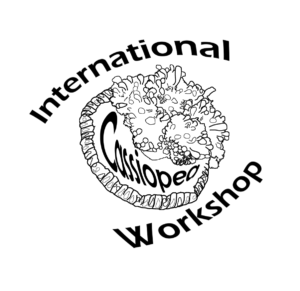
5th Annual International Cassiopea Workshop
Abstracts
Cherry Lewis- Ames Tohoku University/ Smithsonian NMNH
The upside-down jellyfish has soared since its pro-star debut at the 1st International Cassiopea Workshop (ICW) in 2018. Starting with a major review paper, followed by draft genomes and transcriptomes, along with the discovery of sleep, plasticity and fluid dynamics of these spectacular jellyfishes, our knowledge and community base has undergone a stellar explosion. In 1810, when Péron & Lesueur assigned the upside-down jellyfish to the genus Cassiopea after the ancient celebrated constellation “Cassiopeia” it all but guaranteed its future a scientific superstar. I highlight the discovery of cassiosomes and Cassiopea’s role in pioneering the fieldable eDNA sequencing kit (FeDS); findings made possible thanks to the ICW community.
Lior Applebaum – Bar Ilan University
Sleep is vital for survival and all animals with a nervous system, ranging from jellyfish, to fish and humans sleep. Although sleep clearly improves brain performance, even invertebrates with simple nerve nets sleep, and the core cellular function of sleep is unclear. We hypothesize that single neurons require sleep. The zebrafish enables the study of the physiology of defined single cells in the context of an intact nervous system in a live animal. We combined imaging of single chromosomes and repair proteins, 3D particle motion analysis, optogenetics stimulation, as well as calcium imaging to study the interaction between sleep, neuronal activity, DNA damage and repair. We found that sleep upregulates nuclear maintenance in neurons.
Brad Gemmell University of South Floridal
Cassiopea spp. are common residents in the shallow, sheltered waters adjacent to stands of red mangrove trees. In these regions, Cassiopea can dominate the benthos with peak densities documented to exceed 100 individuals per square meter (mean 29 ind m-2). Using a variety of techniques from novel in situ particle image velocimetry (PIV) instruments to standard gut content microscopy, our aim was to quantify some of the impacts these animals have within their habitat. We measured the vertical volumetric flow rate to be 212 Lh-1 for average-sized animals (8.6 cm bell diameter), which translates to turnover of the entire water column every 15 min for a median population density. In addition, we found Cassiopea sp. are capable of releasing porewater into the water column at a rate that can significantly alter nutrients in the water column. We also explored the ability and frequency of these animals to move across the substrate, the impact of temperature and salinity on pulsation rates, as well as quantifying the diet over a 24 hr cycle. We found non-random movement and self-arrangement as well as consumption of large quantities of zooplankton. In this presentation we will discuss and consider these results and more in the context of an ecosystem engineering role for Cassiopea spp.
Addie Harrison University of Arizona.
Nematocysts are stinging organelles found in organisms such as jellyfish, anemones, and hydrozoans. The immersed boundary method is used to couple the elastic equations and the fluid equations to numerically simulate nematocyst firing and ejecting dynamics. Our preliminary results show that the nematocysts ability to accurately hit and puncture a surface it is projected to hit can vary based on the acceleration used to fire as well as the target’s size and makeup.
Megan Maloney- Auburn University
In the face of changing climates, some organisms respond by adjusting morphological or physiological characteristics. This plasticity enables some organisms to survive variable environments, whereas others cannot. Cassiopea sp. are highly tolerant to environmental stress which may be due to their ability to regulate bell pulsation. We measured pulsation metrics during a lethal heat stress to address the hypothesis that phenotypic plasticity contributes to their ability to survive.
Louis Schlecker – Smith College
The facultative symbiotic anemone Exaiptasia diaphana is used as a model organism to study symbiotic contributions to host stress resilience. Standard protocols for generating aposymbiotic Exaiptasia include cold shock stress, which is supposedly less stressful than bleaching via heat stress. We subjected Exaiptasia to gradual (1℃/day) and abrupt cold and hot treatments to compare host stress responses.
Caroline Link – New College of Florida
We compared the thermotolerance of Symbiodinium (CassEL-1) when in culture versus in hospite within C. xamachana ephyrae. CassEL-1 cultures were thermosensitive, while in hospite communities displayed significantly increased thermotolerance at the onset of treatment but which began to fade after 6 days at 32℃. This suggests that Cassiopea may provide symbionts with some degree of a protective effect during initial stress exposure.
Rachel Wright – Smith College
Global climate change threatens marine organisms with multiple simultaneous stressors. Here we assess anemone health under four treatments: control, increased light, increased nutrients, increased light+nutrients. We conducted these treatments using five genets of anemones in the symbiotic and aposymbiotic states. Our results demonstrate the importance of assessing the health impacts of combined environmental challenges and highlight how symbiotic state modulates holobiont stress responses.
Madison Emery – Auburn University
To investigate the potential tradeoffs between symbiosis and immunity we utilize the facultatively symbiotic Cassiopea polyps to determine the impact of symbiotic state on disease pathology. Symbiotic Cassiopea polyps are more susceptible to both Vibrio coralliilyticus and Serratia marcescens infection relative to their aposymbiotic counterparts. To further investigate this effect we measure polyp physiology.
Christina Hamlet – Bucknell University
Cassiopea uses the pulsations of its bell to drive fluid across its oral arms for fluid sampling to feed, remove waste, regulate temperature, among other functions. Fluid flow through the oral arms may be altered depending on the configuration of the structures, allowing the oral arms to act more as solid plates or leaky rakes, depending on the characteristics of the flow and the need of the organisms. I will present work showing how the spacing between structures changes the flow dynamics at the scale of the finest structures of the oral arms (digitata)
Matea Santiago – University of Arizona
Soft corals in the family Xenia rhythmically pulse their tentacles to enhance the photosynthesis of their symbionts, similar to the Cassiopea jellyfish. We seek to understand the role of pulsing in oxygen removal near the coral tentacles where the symbiotic algae are located by considering the oxygen to be a passive concentration in the fluid. The length of the resting phase is varied to understand the pulsing motion’s effect on the concentration dynamics. Preliminary results will be presented.
Natalia Lopez-Figueroa – University of South Florida.
Members of the Genus Cassiopea have been studied since the 1990s for their semi-sessile benthic behavior and for bearing algal symbionts analogous to their anthozoan counterparts, stony coral, making them excellent laboratory models to study host-symbiont relationships. Historically, research on upside-down jellies has focused on their life history and symbiotic relationships, with most studies carried out in laboratory settings. Much less information is available about their field ecology, though high population densities of upside-down jellies have been linked with human activity in nearshore environments. Recent studies have proposed the use of Cassiopea as bioindicators for detecting nutrient pollution as they appear to thrive on increased nutrient availability. In this review, we assess the published literature of Cassiopea with the goal to identify the major gaps in understanding their field ecology and potential as bioindicators. Using internet-based searches up to October 2021, 102 papers on Cassiopea were located, 77% of the published literature have been lab-based studies, with the remainder being field studies and reviews. Historical papers date back to 1900, with a subsequent exponential increase in numbers of studies, peaking in the 2010–2019 decade. Field studies became more frequent beginning in the early 2000s. This literature review provides a baseline for understanding the existing realm of Cassiopea research and indicates that field-based studies could enhance understanding of their role in anthropogenically-impacted environments.
Shio-Han Hung – King Abdullah University of Science and Technology
To understand the molecular mechanisms behind this symbiosis, gene expression profiles between aposymbiotic and symbiotic Cassiopea polyps were compared, revealing genes and pathways putatively involved in symbiosis. We identified 1,227 differentially expressed genes out of 63,340 transcripts, with 560 upregulated and 667 downregulated in symbiotic polyps. GO enrichment analysis indicated that processes linked to lipids, sterols, cholesterol, and membrane transport were upregulated in symbiotic.
Justin Darymple – Florida International University
Co-investigators: Luciano T. Simonetta, Anthony J. Bellantuono, Matthew DeGennaro
Coral bleaching is the expulsion of intracellular photosymbionts by their coral hosts in response to stress. While bleaching is projected to be a growing problem for the world’s reefs, molecular mechanisms underpinning bleaching remain unclear. We performed a mechanism-agnostic screen to identify underlying candidate pathways in the model symbiotic anthozoan Exaiptasia diaphana. Anemones were exposed to 1,280 human pharmaceuticals for 96 hours before bleaching was assessed by fluorescence. Since pharmaceuticals interact with known targets, this approach represents a novel method for understanding the mechanistic basis of dysbiosis. Preliminary analysis reveals over 70 compounds that cause bleaching in anemones, including medications prescribed for psychiatric disorders, osteoporosis and blood pressure.
Diana Francis – University of California, Berkeley
We sequenced RNA from baseline and sleep deprived animals and found differential expression (DE) in many sleep-related genes. One nicotinic acetylcholine receptor alpha subunit (nACHRa) is highly DE, and characterization has supported a sleep-related function within the ganglia. Further, we developed RNAi for use in Cassiopea to knockdown target expression and determined that this nACHRa plays a role in regulating sleep homeostasis, as treated animals slept far more in the day (~35%) and less
Michael Abrams – University of California, Berkeley
By tracking the propensity of ganglia to initiate contractions over days and nights we are able to determine how neural activity changes between sleep and wake in Cassiopea. Long-term ganglia usage hierarchies exist and active ganglia exchange with inactive ganglia over time. Ganglia-network sleep/wake activity patterns can range from being highly specialized to completely unspecialized. Further, ganglia activity in sleep-deprived animals becomes far more sleep/wake specialized.
Ranjith Lakshmanan – Indian Council of Agricultural Research – Central Marine Fisheries Research Institute
The present study describes the upside-down jellyfish, Cassiopea ephyrae and young medusa developmental morphology at different time intervals under a controlled rearing system for the first time from Indian waters. The newly released ephyrae of upside-down jellyfish Cassiopea were collected from the primary settlement unit of a slow sand filter facility with the source seawater from the Tuticorin Bay, the Southeast coast of India. The newly liberated ephyrae NLE (1.4-2.5 mm) differs from reported scyphozoan morphogenesis differs in its morphology and development. It has a very long manubrium length (more than half of the central disc diameter), the presence of 16 spatula-shaped velar lappets and 32 outward bent tip rhopalial lappets with zooxanthellae distributed in the mesoglea. The ephyra development starts with the formation of four lips with digitata in the manubrium. As the ephyra grows, the first four gastric filaments develop and form the manubrium, and four oral arms extend to get bifurcated, forming eight early oral arms. This sequence is followed by developing vesicles in the arms and the disc centre in the young medusa. The study revealed that the ephyrae readily accepted live feed in laboratory conditions and recorded substantial growth and morphogenesis to young medusae of Cassiopea spp. In the current present investigation, the development of the ephyrae to young medusa takes 3 to 4 days under controlled laboratory conditions.
Kaden Muffet – Texas A&M – Galveston
The extent of Cassiopea diversity within the Florida Keys has long been disputed. Collecting 55 Cassiopea from 8 sites stretching the length of the Keys, we are able to bring more data to bear on this issue. Using COI and 16S, we demonstrate a combination of two species sympatric at multiple sites. The two profiled species, C. xamachana and C. andromeda*, are morphologically cryptic but present in very different proportions (10:1) along the length of the Keys.
Natalia Lopez-Figueroa – University of South Florida
Historically, research on upside-down jellies has focused on their life history and symbiotic relationships, with most studies carried out in laboratory settings. Much less information is available about their field ecology. High population densities of upside-down jellies have been linked with human activity in nearshore environments. For example, Cassiopea blooms have been correlated with human-impact such as dredging in coastal environments. The Jobos Bay Natural Estuarine Research Reserve dredged a salt pond within a salt marsh during habitat restoration of shorebird nesting areas. Shortly after the pond was dredged a Cassiopea outbreak was observed in the pond. We addressed recruitment of this population by testing substrate preference of Cassiopea larvae using settlement-tile experiments. This pilot study was conducted beginning in December 2020. Tiles were deployed in six locations in the salt pond, each set contained five different treatments based on preferred substrates from reports of lab-based experiments. Juvenile Cassiopea were observed on tiles within six weeks of deployment. Environmental data demonstrated a temperature gradient in the salt pond and a wide fluctuation in pH. Nutrient data indicated that sites within the salt pond exhibited nitrate limitation, while water in the channel that enters the lagoon from Jobos Bay showed phosphate limitation. This pilot study provides insight into Cassiopea bloom dynamics in their natural habitat, which opens new horizons for future work with these magnificent organisms.
Raphaël Aguillon – Bar Ilan University
The circadian clock regulates daily oscillations in molecular, physiological, and behavioral processes that anticipate sunrise and sunset in animals ranging from cyanobacteria to cnidarians to humans. The intrinsic clock is driven by environmental cues such as light, food and temperature. Extensive research in invertebrates and vertebrates has characterized the fundamental factors and mechanisms of the molecular clock, which are evolutionarily conserved. It involves multiple negative feedback loops including transcription factors, which oscillate on an approximately 24-hour cycle. One of the key regulators of this mechanism is the conserved transcription factor bHLH CLOCK, which acts in dimers to regulate the expression of clock-controlled genes. The clock gene and its homologues have been identified in all animal clades, including cnidarians, basal metazoans, suggesting that the circadian clock evolved at this stage of animal evolution.
The nocturnal sea anemone Nematostella vectensis has a 24-hour rhythmic behavior in both light and dark and in constant darkness. This free-running behavior in the absence of external signals suggests a functional intrinsic circadian clock. Unconventionally, we found that the orthologous genes of the central clock are rhythmic only in the light/dark cycle. These results call into question the CLOCK protein as a central regulator of the circadian clock in early animal lineages. To test the function of the ancient CLOCK, we generated a CRISPR-mediated clock mutant of N. vectensis. By combining video tracking of behavior, whole transcriptome sequencing, and high-resolution anatomical studies in the clock mutant, we investigate the origin of time in animals.
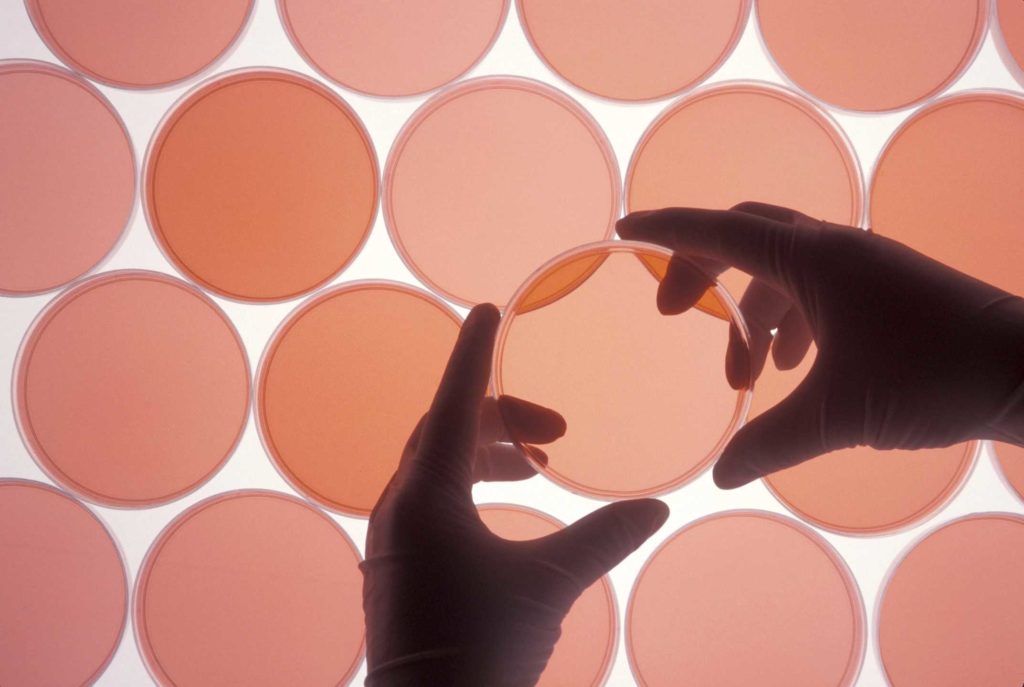
4th Annual International Cassiopea Workshop (virtual)
May, 2021
Abstracts
Nicholas Battista
Much effort has been placed into understanding jellyfish maneuverability and swimming performance by the computational fluid dynamics community. However, there is still much to be learned about the jet propulsive locomotive gait displayed by prolate jellyfish. Traditionally, computational models have assumed uniform duty cycle kinematics from cycle to cycle. However, we determined that possible enhancements in swimming performance were possible by shuffling different duty cycles together across multiple Reynolds numbers and contraction frequencies. Increases in speed and reductions in cost of transport were observed as high as 80% and 50%, respectively. Generally, the net effects were greater for cases involving lower contraction frequencies. Overall, robust duty cycle combinations were determined that led to enhanced or impeded performance.
Bradford Dimos
Thermally induced breakdown in the symbiosis formed between symbiotic cnidarians and dinoflagellate algae in the family Symbiodiniaceae threatens the future of reefs worldwide. This process is thought be initiated by photosynthetic dysfunction of the algal symbiont, however new research also implicates host mitochondria as potentially playing a role in the process of bleaching. However, the effect thermal stress has on host mitochondrial function and how this relates to symbiosis breakdown in Cnidarians, has not been investigated. By using the model organism Cassiopea xamachana we test the hypothesis that exposure to increased temperatures leads to damage to the host mitochondria and that these changes accompany bleaching. We show that exposure to temperature stress increases the demand placed on mitochondria leading to mitochondrial damage in the form of reduced membrane potential. These physiological changes co-occur with reductions in symbiont colonization, opening up new lines of investigation into the interaction between mitochondrial function and the breakdown of symbiosis.
Natalia Carabantes
Cassiopea xamachana has been considered a model organism for studies in biological and ecological aspects of the symbiosis in coral reef systems. One important aspect of the study of this organism is the knowledge of its microbial community. The microbial community associated with cnidarian hosts has a major role in the protection and recycling of nutrients, contributing to their health. We present the first characterization of the bacterial community associated with the surface mucus layer of Cassiopea xamachana collected from Nichupté lagoon, México. We evaluated the effect of the loss of symbionts (experimental bleaching) on the bacterial composition of this layer and compared their diversity in summer and winter, through the analysis of 16S rRNA gene high-throughput sequences. The density of symbionts, was experimentally diminished using a mix of sugars. In summer, bacterial composition in symbiotic medusas was more diverse than in winter. The loss of symbionts reduced the bacterial diversity of medusas sampled in summer, but the bacterial diversity in winter was higher in bleached medusas. Bacterial community analysis suggested that season and symbiotic condition were both important in defining the bacterial composition of medusas. However, the LDA analysis showed that although genera were different between seasons, the dominant genera did not change with the season. The bacterial community of symbiotic medusas was dominated by the genus Endozoicomonas, while the genus Vibrio dominated under the bleached condition, consistent with other studies in corals. Our results suggest that symbionts have a major influence in structuring the bacterial community associated with the surface mucus layer of C. xamachana.
Karly Higgins-Polir
Cassiopea xamachana is rapidly becoming a model for (jellyfish) symbioses, illuminating a variety of behaviors, symbiotic interactions and associated life histories. We are interested in exploring the utility and range of applicability of this model for other jellyfishes. Rapidly evolving populations of genetically, morphologically and behaviorally diverse Mastgias papua inhabit marine lakes in Palau. Like C. xamachana, these medusae normally contain endosymbiotic, photosynthetic zooxanthellae contributing to their common name: golden jellyfish. These animals have distinct horizontal migratory patterns adapted to each lake, but their interaction with the zooxanthellae is unknown. Unexpectedly, in 2016, ENSO decimated a mass occurrence of millions of M. papua in Jellyfish Lake, Palau. Upon population recovery we noticed a number of white medusae, apparently lacking zooxanthellae. This natural phenomenon provided the opportunity to assess the impacts of missing symbionts in medusae with a direct comparison between the white and golden phenotype. We swam transects and collected data on swimming direction, showing white medusae did not have significant migratory patterns in contrast to the largely documented horizontal migration of the golden medusae. This observational study is the first to suggest symbionts mediated behavioral differentiation within a single lake population in Palau.
Alexander Hoover
Cassiopea spp., or upside-down jellyfish, represent a prime example of a benthic medusae. Their behavior is characterized by forming carpets with other upside-down jellyfish that collectively act as nutrient pump in the shallow water biomes that they inhabit. In this talk we present a 3D computational model that describes the biomechanics of upside-down jellyfish and characterizes the flow patterns generated by their motion. With this model we examine approaches for modeling a Cassiopea’s oral arms and their influence on the resulting fluid dynamics.
Sandra Loesgen
Niclas Lynby
The upside-down jellyfish Cassiopea engages in symbiosis with photosynthetic microalgae that facilitate uptake and recycling of inorganic nutrients. By contrast to most other symbiotic cnidarians, algal endosymbionts in Cassiopea are not restricted to the gastroderm but are found in amoebocyte cells within the mesoglea. While symbiont-bearing amoebocytes are highly abundant, their role in nutrient uptake and cycling in Cassiopea remains unknown. By combining isotopic labelling experiments with correlated scanning electron microscopy, and Nano-scale secondary ion mass spectrometry (NanoSIMS) imaging, we quantified the anabolic assimilation of inorganic carbon and nitrogen at the subcellular level in juvenile Cassiopea medusae bell tissue. Amoebocytes were clustered near the sub-umbrella epidermis and facilitated efficient assimilation of inorganic nutrients. Photosynthetically fixed carbon was efficiently translocated between endosymbionts, amoebocytes and host epidermis at rates similar to or exceeding those observed in corals. Amoebocytes thus play a vital role for the assimilation and translocation of nutrients in Cassiopea, providing an interesting new model for studies of metabolic interactions in photosymbiotic marine organisms.
Megan Maloney
The upside–down jellyfish (Cassiopea xamachana) is an emerging model organism used to understand symbiotic relationships between cnidarian hosts and dinoflagellate algae. As sea surface temperatures increase, the geographical ranges of C. xamachana is expanding rapidly. However, our understanding of population structure, genetic variation, and the extent of clonality amongst C. xamachana populations remains limited. Because C. xamachana from the Florida Keys are often chosen for symbiosis research, is imperative to identify potential host genetic factors that contribute to their phenotypes. Further, the morphological variation of C. xamachana is conspicuous but what drives this remains unknown. Therefore, we will attempt to find connections between morphological variation and genetics across this environmental range. The objective of this project is to characterize the populations structure of C. xamachana and understand capacity of this organisms to adapt to a changing climate. Adult medusa have been collected from Florida Bay and Atlantic sites across the Florida Keys. These results will provide the foundation for studies on the role of phenotypic plasticity in C. xamachana and their ability to thrive in a changing climate. Genetic data will enhance our understanding of variation across a relevant geographical range and help identify factors involved in their resilience to a changing climate.
Martha Mammone
Ecological profiling of non-native species is essential to predict their dispersal and invasiveness potential across different areas of the world. Cassiopea is a monophyletic taxonomic group of scyphozoan mixotrophic jellyfish including C. andromeda, a recent colonizer of sheltered, shallow-water habitats of the Mediterranean Sea, such as harbors and other light- limited, eutrophic coastal habitats. To assess the ecophysiological plasticity of Cassiopea jellyfish and their potential to spread across the Mare Nostrum by secondary introductions, we investigated rapid photosynthetic responses of jellyfish to irradiance transitions – from reduced to increased irradiance conditions (as paradigm of transition from harbors to coastal, meso/oligotrophic habitats). Laboratory incubation experiments were carried out to compare oxygen fluxes and photobiological variables in Cassiopea sp. immature specimens pre- acclimated to low irradiance (PAR=200 μmol photons m−2 s−1) and specimens rapidly exposed to higher irradiance levels (PAR=500 μmol photons m−2 s−1). Comparable photosynthetic potential and high photosynthetic rates were measured at both irradiance values, as also shown by the rapid light curves. No significant differences were observed in terms of symbiont abundance between control and treated specimens. However, jellyfish kept at the low irradiance showed a higher content in chlorophyll a and c (0.76±0.51SD vs 0.46±0.13SD mg g-1 AFDW) and a higher Ci (amount of chlorophyll per cell) compared to jellyfish exposed to higher irradiance levels. The ratio between gross photosynthesis and respiration (P:R) was >1, indicating a significant input from the autotrophic metabolism. Cassiopea sp. specimens showed high photosynthetic performances, at both low and high irradiance, demonstrating high potential to adapt to sudden changes in light exposure. Such photosynthetic plasticity, combined with Cassiopea eurythermal tolerance and mixotrophic behavior, jointly suggest the upside-down jellyfish as a potentially successful invader in the scenario of a warming Mediterranean Sea.
Madeleine Mckenzie
Coastal marine systems are exposed to a diversity of contaminants, and for many, their influence on marine ecosystems is unknown. Historically, biomonitors have been used as effective tools to monitor the occurrence and level of contaminants in ecosystems. Sedentary organisms like molluscs are commonly used, however their utility to detect short-term pulse exposure events is low. Recent studies have highlighted the potential of the upside-down jellyfish, Cassiopea, as a biomonitor. This jellyfish possesses many of the key criteria of an ideal biomonitor, such as: 1) they accumulate contaminants in tissues, 2) are a sedentary species, 3) are tolerant to changes in water quality, 4) are tolerant to handling, and 5) are easily identifiable. Cassiopea have also been shown to accumulate contaminants over a period of days to weeks, and can excrete them within a similar time interval, highlighting their potential to detect short-term pulse events. Using laboratory and field experiments, Cassiopea will be exposed to contaminants singly, in combination, and in the presence of an environmental factor to assess their responses. This research will determine the effectiveness of Cassiopea as a biomonitor to contaminants found in coastal marine systems. Ultimately this will aid in the development of early detection and quantification tools to help assess risks and help to fill knowledge gaps on the effects of contaminants on marine organisms.
Jennica Moffat
Marcela Rai
Cassiopea xamachana, commonly referred to as upside-down jellyfish, serve as extremely valuable model organisms when studying the mechanisms of establishment, maintenance, and stress tolerance of marine symbioses (Ohdera el. al, 2018). In particular, Cassiopea is notable for their symbiotic relationship with photosynthetic dinoflagellates within the family Symbiodiniaceae and are most commonly used as a more easily cultured and managed alternative to stony corals (Rädecker el. al, 2017). The asexual reproduction of Cassiopea in the scyphistoma stage, known as strobilation, is particularly interesting because its initiation requires the suppression of host immune response, allowing for the colonization of Symbiodiniaceae (Hoffman et. al, 1996). Previous studies have found that Symbiodiniaceae growth and survival is influenced by environmental factors such as salinity, temperature, and light intensity, with different species varying in their tolerance to these external influences (Díaz-Almeyda et. al, 2017; Rogers and Davis, 2006). Notably, the rate of strobilation is dependent on the relative health of the Symbiodiniaceae endosymbionts (Hoffman et. al, 1996). While this symbiotic pair has been well studied within separate adult medusa stage Cassiopea (Hopf et. al, 2013) and isolated Symbiodiniaceae cultures (Klueter et. al, 2017), there is a lack of insight pertaining to the effects these external factors may have on the fitness of the early-stage symbiosis. This study aims to contribute to this gap by tracking the strobilation rate of Cassiopea xamachana scyphistoma infected with Symbiodinium microadriaticum (CassKB8) exposed to varying levels of salinity, temperature, and light exposure. No distinction in strobilation rate was observed between scyphistomae grown at varying light and salinity levels, however, increased temperature stimulated a faster strobilation process compared to control treatments. Furthering our understanding of external influences on the early stages of this model symbiosis will allow for future applications relating to selective colonization of endosymbionts in cnidarians. This in turn could be utilized in the study of environmental effects on symbiotic systems, and the understudied symbiont in these systems, Symbiodiniaceae.
Arvin Santhanakrishnan
Rachel Stein
Christopher Strickland
In this talk, I will introduce a computational framework written in Python for modeling the collective motion of small organisms in 2D or 3D fluid flow. Features include the automated import of VTK data sets specifying time-varying fluid velocity fields, import of static mesh structures (vertices or stl format) which act as solid barriers to agents, an Ito stochastic differential equation solver along with the ability to specify more ad-hoc agent behavior, and plotting of results. Work is ongoing with plans to include a method for calculating the FTLE field which can operate on generalized, deterministic movement.
Shelley Templeman
Gloria Lorena Velasquez Mejia
The increasing of the temperature and acidification in the ocean as a result of anthropogenic activities generate negative effects on the function and structure of marine ecosystems, among the most affected are corals reef which are highly diverse and valuable ecosystems. Despite the importance, studying them in the laboratory presents difficulties, such as their slow growth, limits on acclimatization variables, and protected status. The upside-down jellyfish Cassiopea xamachana has emerged as a study model of corals, as it is easily cultured in laboratory, its life cycle is controlled, and the Cassiopea genus is highly dependent on its symbiosis with microalgae of the Symbiodinium genus as are the corals.
In this study, we evaluate how different combinations of temperature and pH affect the density of Symbiodinium microadriaticum (reinfection) in bleached polyps of C. cf. xamachana. Polyps were subject to high temperatures, menthol and saccharides to initiate algae expulsion and obtain bleached polyps. Bleaching was confirmed by optic and epifluorescence microscopy. Bleached polyps were subjected to different treatments (infected with fresh cells of S. microadriaticum isolated from an adult medusa), and controls (without S. microadriaticum); both with replicates and different combinations of temperature (29, 32 and 34 oC) and pH (8.20, 7.50 and 7.20) for 16 days. Polyps were collected at 2, 4, 8 and 16 days post treatments; reinfection was confirmed and imaged by optic and epifluorescence microscopy. Images were edited with ImageJ program to determine the S. microadriaticum density. The results for the bleaching induction showed that high temperatures were not effective to obtain bleached polyps; however it induced the strobilation. Menthol dose used was lethal for the polyps; while saccharides treatment was the most effective method to induce bleaching. In addition, the reinfection observed as density was higher in a neutral pH (8.20) and temperature (29 °C), these density decreases in an acid pH (7.20) and higher temperature (34 °C).

3rd Annual International Cassiopea Workshop
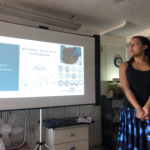
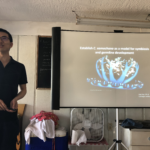
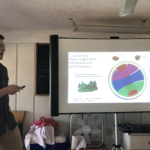
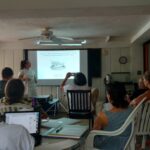

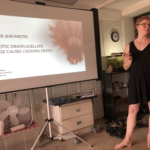
Abstracts
Michael Abrams – UC Berkeley
Sleep is a quiescent behavioral state associated with reduced responsiveness to weak stimuli and rapid reversibility in response to strong stimuli. Following sleep curtailment, some animals sleep more deeply, whereas others extend the duration of their sleep, or sleep at inappropriate times, all aspects of homeostatic regulation. Clearly sleep affects the activity of the entire animal, and intuitively one might suppose that sleep must then be regulated in a top-down matter (centrally organized). However, our recent discovery that Cassiopea has a sleep-like state supports the idea that sleep predates the centralized nervous system, and adds credence to an alterative theory, that sleep is an emergent property of neural networks – the bottom-up view. Cassiopea, like other scyphomedusae, have radially symmetrically placed neural clusters, called rhopalia, that organize the muscle contractions involved in the pulsing behavior and response to stimuli. Tracking the activity of rhopalia, by visually locating the site of pulse initiation, has the power to illuminate many aspects of Cassiopea behavior. Through high- speed video analysis we have found that certain rhopalium appear to lead the majority or plurality of pulses in a given day/night cycle, and that these leaders can persist for many hours. However, over consecutive day/night cycles, the lead rhopalia change. These initial findings indicate the importance of spatio-temporal patterns in determining the structure of this decentralized system. Excitingly, the most active rhopalia at the end of the day appear to decrease their activity at night relative to the other rhopalia – a direct connection to the homeostatic component of sleep. Through further analysis of Cassiopea behavior, combined with molecular biology approaches, we may determine how sleep is organized in this decentralized system, one that may be similar to that of the ancient cnidarian-bilaterian ancestor.
Viridiana Avila Magana – Pennsylvania State University
Endosymbiosis requires genome regulation of expression in the other partner. Regulatory networks in endosymbiosis between host-symbiont may be governed by direct mechanisms by targeting the molecular machinery of each other by direct or by indirect regulatory pathways.
miRNAs are eukaryotic small RNAs responsible for the regulation of a significant part of the cellular gene expression. They act by targeting the UTR sequences on target mRNA. miRNAs have been implicated in the evolution of novel phenotypic traits. Several studies on cross- miRNAs trafficking suggest that these molecules may regulate ecological interactions (e.g. host-pathogen) between species.
Cnidarian miRNA research is still in its infancy, but some preliminary studies suggest that miRNAs may be involved in cnidarian-algal symbiosis. A key question remains: How does post-transcriptional regulation triggered by symbionts launches host downstream key developmental programs in Cassiopea xamachana?
Through small RNA and transcriptomic profiling, we identified miRNAs in C. xamachana expressed during the onset of symbiosis and metamorphosis stages and during symbiosis breakdown under thermal stress in fully developed/symbiotic strobilae. We found that miRNA regulation is involved in the establishment of photosymbiosis in C. xamachana. Aposymbiotic polyps overexpressed a specific miRNA (Cxam-miRNA5) whereas polyps at 3 days colonization with the homologous symbiont Symbiodinium microadriaticum underexpressed this particular miRNA. Furthermore, an opposite trend is observed in fully symbiotic strobila jellyfish where symbiosis disruption takes place and this miRNA is overexpressed. These results suggest a symbiosis post-transcriptional regulatory mechanism participating in the activation of a developmental program induced by the early colonization of Symbiodiniaceae and by the disruption of symbiosis during thermal stress.
Anthony Bellantuono – Florida International University
Warming oceans disrupt the critical endosymbiosis between corals and their photosynthetic dinoflagellate endosymbionts of the family Symbiodiniaceae. Durusdinium trenchii is a heat-tolerant species of Symbiodiniaceae and enhances survival of its coral host, but the basis for tolerance is largely
unknown. To identify the underpinnings of heat tolerance and symbiosis, we compared the in hospite and free-living transcriptomes of D. trenchii under stable temperature conditions and acute hyperthermal stress. We discovered that under stable conditions, in hospite cells exhibit lower transcriptional activity than free-living counterparts, suggesting the shutdown of genes uniquely required for a free-living lifestyle. However, under hyperthermal stress the transcriptional response was larger in hospite, indicating an exacerbated stress environment within the host cell. Significantly, we unraveled the molecular signatures of symbiont heat tolerance within the host, which is a critical step to enable the development of engineered endosymbionts as a tool for restoration of coral reefs.
Bradford Dimos – University of Texas, Arlington
Cassiopea xamachana are a versatile model organism to use in the study of cnidarian cell biology. Foremost among the goals of studying cnidarians is understanding how these ecologically important organisms cope with changing environmental conditions and the challenges to cellular function that imposes. Recently a highly-conserved stress response pathway termed the mitochondrial unfolded protein response (UPRmt) was found to exist in reef-building corals which is vital to mitigating cell stress in these animals. C. xamachana contains clear homologs to the elements of the UPRmt and developing genetic tools including gene knock-down, generation of reporter lines, and forward genetic screens will be critical to further characterizing this important cell stress axis. Here we discuss recent progress in development of genetic techniques as well as approaches moving forward.
Christina Hamlet – Bucknell University
Cassiopea, like many other marine organisms, rely on particle exchange achieved by moving fluid across or through various structures. Branching or bristled structures can reconfigure at the smallest length scale in order to act as impermeable structures or as porous structures to facilitate particle exchange. I will discuss the challenges involved in modeling these leaky to solid transitions and some approaches to studying and simulating the fluid dynamics of particle capture and exchange in upside- down jellyfish.
Matthew DeGennaro – Florida International University
Understanding the mechanisms of coral symbiosis and dysbiosis offers the promise of facilitating the restoration of coral reef habitats across the world. To understand how cnidarians live with their dinoflagellate endosymbionts, my lab has been attempting to establish Aiptasia as a genetically accessible, laboratory model organism. Our progress has been hampered as the organism is unablw to complete sexual reproduction in the laboratory due to the inability of the larval next generation to settle and grow to sexual maturity. We will present our current progress in overcoming this issue and in using genome editing to achieve targeted mutagenesis.
Shiou-Han Hung – King Abdullah University of Science and Technology shiou-
Tropical coral reefs are considered one of the most diverse and productive ecosystems on the planet. Corals heavily rely on the symbiosis with photosynthetic dinoflagellates of the genus Symbiodinium, receiving photosynthates in exchange for inorganic nutrients. Cassiopea, similarly to corals, has a mutualistic relationship with Symbiodiniaceae. Albeit, is a more amicable system when compared to hard corals, as this upside-down jellyfish can be easily maintained in laboratory conditions, has a closed sexual reproductive cycle, and short generation time. The use of Cassiopea as a model organism to investigate symbiosis with Symbiodinium, would provide us with a better understanding of Cnidarian symbiosis and would bring us a step closer to the development of a cnidarian symbiosis model. We are currently in the process of replicating Cassiopea’s life cycle ex-situ under controlled laboratory conditions to define a protocol describing the handling and maintenance of aposymbiotic and symbiotic
Cassiopea in the laboratory. Furthermore, we will assess and compare preferences and incompatibilities of Symbiodiniaceae associations in Cassiopea to the Exaiptasia model. We will conduct transcriptome profiling of aposymbiotic and symbiotic Cassiopea aiming to identify genes related to symbiosis. A cross- comparison with data available for the sea anemone Exaiptasia, will allow to identify if the symbiosis in Cassiopea is analogous to those reported in sea anemones or corals. Moreover, genes of interest will then be targeted for knockout using CRISPR-Cas9 for testing their functionality related to endosymbiosis. The whole project aims to have implications and benefits for the scientific community by developing Cassiopea as a model organism for symbiosis and by providing a platform to conduct transgenic and gene knockout experiments.
Allison Kerwin – McDaniel College
The upside-down jellyfish, Cassiopea xamachana, is a useful model system for coral tri-partite interactions between the cnidarian host, the photosymbiont, and the bacterial microbiome. The bacterial microbiome of C. xamachana’s polyp stage, and how that community changes as a result of strobilation when photosymbiosis is initiated, remain open questions. To begin to address these questions, C. xamachana polyps were sampled prior to infection with Symbiodinium microadriaticum, at three and eight days post-colonization, and as strobila (n=3 per timepoint). RNA was extracted and processed for Illumina sequencing, and the bacterial fraction analyzed. Bacterial activity appeared to be crucial for the developmental transition, as bacterial transcripts were present at much higher levels than in other similar C. xamachana metatranscriptomes from our lab. Establishing the ontogenetic microbiome of C. xamachana, and how metamorphosis and photosymbiosis onset affects that microbiome, will improve our understanding of cnidarian holobiont interactions. The importance of understanding these interactions will only increase as coral reefs undergo increasing mortality events from global climate change.
Frank Mari – National Institute of Standards and Technology
Laura Miller – University of North Carolina, Chapel Hill
Numerous small organisms that swim, fly, smell, or feed in flows at the intermediate scale (mesoscale), where inertial and viscous forces are balanced, rely on using branched, bristled and hairy structures. Such mesoscale structures can augment underlying biological function, such as particle capture, by moving in a manner to transition from acting as solid surfaces to leaky/porous rakes at Reynolds numbers (Re) close to one. Although mesoscale flows have been studied in many organisms, the fluid dynamic mechanisms underlying the leaky rake to solid plate transition remain unclear. A detailed understanding of how this leaky-to-solid transition affects chemical exchange and particle capture in mesoscale filtering, where advective and diffusive transport rates are nearly balanced with Peclet number (Pe) close to one, also remains unavailable. In this presentation, I will describe the fundamental fluid dynamics of biological and bioinspired filtering arrays at Re and Pe close to unity. I will also discuss the implication for upside-down jellyfish oral arms where plankton is captures and nutrients and gases are exchanged. Modeling the leaky-to-solid transition is challenging due to the need to simultaneously resolve small-scale flow around micron-scale structures and bulk flow around millimeter-scale arrays. New mathematical models are being developed by my group to describe effective porosity of these flexible filtering appendages.
Jennica Moffat – California State University, Northridge
We plan to investigate the potential for evolutionary rescue in the model cnidarian-dinoflagellate symbiosis of Cassiopea xamachana and algal endosymbionts (f. Symbiodiniaceae). Evolutionary rescue, the “rescuing” of a population through selection for resistant individuals who survive and reproduce in a declining population, has primarily been studied in the absence of interactions with other species. Past research has investigated the potential for one species to be rescued from extinction; however, the role of evolutionary rescue in symbioses has been largely unexplored. We will use Cassiopea xamachana to investigate how host fitness may be affected by different endosymbiont genotypes. Will genetic and phenotypic differences of the endosymbiont translate to fitness differences in the host, specifically in how the holobiont responds to thermal stress? Finding differential effects of endosymbiont genotypes on host fitness would suggest a potential for evolutionary rescue of the host through rapid evolution of the endosymbiont. This work will have implications for the future of similar cnidarian-dinoflagellate symbioses and conservation efforts focused on genetic and evolutionary rescue in the face of global climate change.
Aki Ohdera – California Institute of Technology
The relative ease of operation, throughput and cost of Next Generation Sequencing platforms have enabled the coupling of traditional field collection methods with laboratory-based metagenomic sequencing approaches to provide a molecular snapshot of species-diversity in many aquatic environments. Unfortunately, the time lag between field sampling, sequencing and endpoint bioinformatics analyses precludes the ability to provide a contemporaneous characterization of the target ecosystem, against the backdrop of shifting global climate. The growing decline of aquatic ecosystems due to chemical, physical and biological threats, along with issues related to invasive species, highlights the critical need for field-forward sequencing protocols that can provide rapid characterizations of environmental communities. The upside-down mangrove jellyfish Cassiopea has been gaining attention as an indicator species, with promising applications for coastal ecosystem management. We developed a field-forward DNA sequencing strategy to collect and analyze environmental DNA from Cassiopea spp. populations inhabiting Florida Keys coastal ecosystems affected by Hurricane Irma in September 2017. The prototype for this portable system provides: 1. A low-complexity protocol requiring minimal training for operation, 2. A relatively short “sample-to- answer” timeframe, 3. Field-forward DNA sequencing capabilities in austere environments, 4. Manual and/or battery-powered operation, 5. A small footprint and ease of portability, and 6. Multiplexing capabilities for the simultaneous assessment of multiple collection sites and/or genetic markers. We present here an assessment of the condition of three Cassiopea spp. populations, based on the findings of our inaugural field-forward sequencing study.
Kemal Ozalp – UNC Chapel Hill
Brine shrimps are planktonic crustaceans that are predominantly located in salt water environments, both on the coast and inland. Nauplius, the first larval stage, passes through 16 more life stages before it becomes adult. During ontogenesis, their morphology and mode of locomotion change dramatically. More interestingly, brine shrimps swim, exchange gas for respiration, and filter feed at the same time. It is unknown how these changes in morphology and swimming method affect physiological functions. Prior work targeting brine shrimp swimming focused on drag generation and was limited to the first 4 larval stages due to the difficulty of running experiments on such a small organism and of the number of life stages. The main focus of this study is to quantify the effect of changes in morphology and swimming on respiration and filter feeding. So far, we have recorded brine shrimps from different life stages using a high-speed camera. Currently, we are working on improving recording quality in order to track active swimming appendages of the animal while swimming.
Liam Pongracz – UNC Chapel Hill
Introduction
Planktonic organisms are roughly less than 1 mm in size and have various methods of locomotion which can affect the survival of these organisms. One method of locomotion that plankton use in their dispersal pattern is moving up and down, despite the presence of local currents that can affect their distribution in the water column. Similarly, the presence of macrophytes can also have an effect on the movement of plankton as they serve as protection for these organisms. Typically, mathematical models have suggested that plankton move passively with the flow of their environment or have another random motion that works in combination with the background flow driving the organisms.
The existing mathematical models assume non-swimming or randomly swimming plankton that disperse through water essentially the same way abiotic particles would. Because plankton are so small and cannot swim well against strong currents, these models do account for the vast majority of movement due to simple dispersal. However, they overlook two confounding variables. They do not take into account the effects of behavioral swimming, such as towards light or towards areas of lower current. They also do not account for the effect of macrophyte beds on water flow. Macrophytes disrupt water flow, causing an area of lower current strength, which may entice plankton to swim towards them for shelter.
Victoria Sharp – Pennsylvania State University [email protected]
Cassiopea xamachana, the upside-down jellyfish, has been reported to undergo injury-induced regeneration of different tissue types in its adult life stage. The details of optimal conditions for this cellular regeneration, the rate and success of regeneration in its various life stages, and the genetic mechanisms underlying this process remain unknown. Additionally, C. xamachana has a uniquely symbiosis-driven metamorphosis. Upon infection with species from the Family Symbiodiniaceae, C. xamachana polyp heads differentiate into ephyra and experience fission
from the polyp stalk, a process called strobilation, after which the polyp head regenerates. I am investigating whether head regeneration still occurs in aposymbiotic polyps, and whether it proceeds at the same rate as head regeneration in symbiotic polyps. Currently I am observing polyp head regeneration through daily surface area measurements of decapitated aposymbiotic polyps. The experiment will proceed with similar rate progression analyses in strobilating polyps and, once timepoints can be established of significant tissue recovery during the regeneration process, the origin of the new tissue will be explored to establish potential gene candidates for genetic activity comparison between symbiotic and aposymbiotic organisms. Through this preliminary research and future experiments with the different life stages of Cassiopea xamachana, I will be able to see how the onset of symbiosis can affect cellular recovery and tissue regeneration in the event of organismal damage.
Kira Turnham – Pennsylvania State University
Members of the diverse dinoflagellate family Symbiodinaceae are important partners in mutualisms involving various invertebrates. For instance, the upside-down mangrove jellyfish, Cassiopea xamachana, requires the symbiont for metamorphosis to adult stages. Though C. xamachana typically form this stable mutualism with a single species of Symbiodinaceae in nature, they are routinely infected in experimental conditions with a variety of cultures belonging to most genera. Symbiodinaceae members of the genus Fugacium appear to be incompatible with experimental aposymbiotic animal hosts. Our recent repeated attempts to experimentally induce stable symbioses of four Fugacium cultured isolates not only resulted
in a failure to infect C. xamachana but also resulted in death of individual polyps. This mortality represents a fitness response worthy of investigation into the mechanism of host polyp death in addition to putative toxins generated within Symbiodinaceae.
Hao Yan – Carnegie Institution for Science
Cassiopea have four typical developmental stages, which are embryonic, planula, polyp and medusae stage. Polyps could generate planula through asexual reproduction while the medusae could generate gametes for sexual reproduction. Juvenile medusae or ephyra is produced through a process called strobilation, which requires algae infection of the polyps. This unique developmental feature makes Cassiopea a fine model to study symbiosis and evolution of germline development. I plan to uncover the potential factors and pathways initiated or induced by algae in regulating germline development and maturation. To accomplish this, I will first use bulk RNA sequencing (RNA-seq) and single cell RNA-seq (scRNA-seq) to identify gene expression features in putative germline cells before and after symbiosis. I
also hope to develop tools such as CRISPR-Cas9 and/or RNAi to manipulation these genes and study if they are involved in germline development.
Daniel Zarate – University of Colorado, Boulder
Cnidarian-dinoflagellate symbiosis are very complex and in many cases highly species specific. Most Cnidarian hosts acquire their symbiont communities, dinoflagellates of the Family Symbiodiniceae, through horizontal transmission. These environmental sources of symbionts can be cryptically found in the water column in their free-living swimming stage. They may also be located within surrounding sediments when dispersed by feces from either predators or hosts. However, it is unknown how lineages of Symbiodiniceae are shared and dispersed across a reef as well as which hosts and species provide greater transmission. Thus, the quantification of host to host transmission rates is vital for understanding how new individual hosts can form and integrate within a reef. The study of these mechanisms require accurate controls over rates of colonization, symbiont species preferences, and known exposures to neighboring hosts. This can be highly difficult considering the lifecycle of Symbiodiniaceae as well as unpredictability for the exact time and rate of colonization into a new host. Therefore, the mangrove jelly Cassiopea spp. is a perfect candidate for this study, as it will only metamorphose through full strobilation when its scyphistomae acquires its symbionts. Another study system is the anemone Aiptasia spp. as it can be fully bleached through menthol anesthesia and then recolonized with known cultures of dinoflagellates. These model organisms can then be used to reveal host to host dispersal paths of symbionts as well as insights on which symbionts are firstly uptaken and integrated. Future studies will also involve common-garden transplant studies among geographical gradients of light and depth.
Yixian Zheng – Carnegie Institution for Science
We at the Embryology Department of Carnegie Institution has started a research program on Cassiopea last summer headed by Dr. Aki Ohdera. The goal is to establish additional methodologies to study the molecular and cellular mechanisms of symbiosis. Aki has established the growth facility in the department and has initiated experiments to optimize growth conditions to achieve rapid reproduction and testing conditions for establishing transgenic Cassiopeia, CRISPR/Cas9 mediated genome engineering, and RNAi. More recently, Dr. Hao Yan has joined this effort. I hope to share our experiences and learn from experts in the field at the workshop.
Adi Zweifler – Bar Ilan University
Environmental cues (e.g. light, temperature, tides) govern circadian and other rhythms in symbiotic marine organisms such as cnidarians, including sea anemones, reef-building corals and probably jellyfish, in regulating biochemistry physiology and behavior. Corals serve as our dominant model system to investigate the dependency between two clock-system associations, coral and symbiotic algae, or non- associations in a simple multicellular organism, on physiological and molecular levels. Cnidarians (corals, sea anemones, jellyfish and hydroids) form a diverse phylum (approximately 9000 species), which live
in an aquatic environment, can serve as marine model organisms. There is a growing interest in the use
of Cnidarians as model organisms due to several reasons: (1) in phylogenetic terms Cnidarian is a sister group to Bilateria (humans included). (2) Relatively simple body complexity enables the tracking of changes following manipulations. (3) Advances in next generation sequencing (NGS) and the establishment of gene manipulating methods. The upside-down jellyfish, Cassiopea xamachana, which possess the same endosymbiotic dinoflagellate algae (Symbiodinium) as corals, have been recently introduced as an alternative model organism to stony corals, in order to understand the mechanisms driving establishment and maintenance of symbiosis.
2nd Annual International Cassiopea Workshop
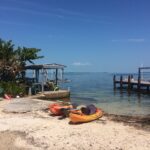

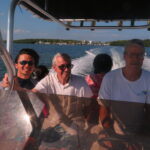
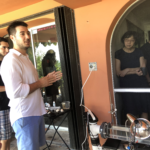
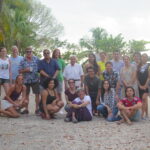
Abstracts
Mónica Medina
Aki Ohdera Penn State University
Most mutualisms involving cnidarians and symbiotic dinoflagellates exhibit high specificity and partner stability. Whether this specificity and stability is conferred/regulated more by the host or symbiont remains largely unknown. The upside-down jellyfish, Cassiopea xamachana , is generally found to host Symbiodinium microadriaticum in nature. However under sterile laboratory conditions, this animal is capable of forming viable symbioses with a multitude of different Symbiodinium species. We took advantage of C. xamachana’s promiscuity under controlled experimental conditions to examine the outcome of symbiont competition within the host. Aposymbiotic polyps of Cassiopea xamachana polyps were exposed to various pairwise combinations of different species of Symbiodinium, with each symbiont introduced at equal and skewed cell proportions. The infected polyps were cultivated for 4-5 weeks until metamorphosis. Following strobilation, the relative abundances for each symbiont pairing were determined among individual juvenile jellyfish using qPCR. Large differences in infection
dynamics were observed depending on the opposing Symbiodinium spp. used, indication that competition between symbionts dictates host-symbiont specificity in nature.
Changing ocean conditions and increasing thermal stress events affect a wide variety of marine organisms, including reef-building corals which exist due to a delicate and obligate symbiosis with Symbiodinium. In an effort to more fully understand this symbiosis several cnidarian model systems have emerged, including the upside-down jellyfish Cassiopea xamachana. However, little is known about the non-Symbiodinium microbiota of this host. In this preliminary study, we completed next generation sequencing of the V4 region of the 16S rRNA gene of a number of wild C. xamachana medusa, examining the arm (n=8), bell (n=5), and gonads (n=5) separately, and compared the community composition of the adults to that of several larvae (n=3). We found that the larval community composition was distinct from that of the adult, but that the microbiome was consistent across adult tissue types. The community appeared to be similar to that of the general coral microbiome, but to be simpler, with hundreds of species instead of the thousands typically associated with a coral sample. Similar to corals, Endozoicomonas was a dominant member of the C. xamachana community, especially in the adult animals. In the future, we hope to expand this analysis to other life stages, and also to examine the effects of strobilation on the microbiome. The use of model systems, including C. xamachana, to examine cnidarian symbioses will only gain in importance as corals experience ever-increasing mortality events.
Christina Hamlet Bucknell
Several systems are required to produce movements involved in feeding behavior. Neural signals produce rhythmic pulsing patterns by inducing muscle contractions. Changes in food, temperature, and light can change the observed pulse patterns, changing the flow around the organism. Understanding how these systems interact with each other using mathematical modeling and computer simulations, guided by experimental observations and results, sheds light into how basic behaviors such as feeding are achieved.
Laura Miller UNC
Viridiana Avila- Penn State University
miRNAs are eukaryotic small RNAs responsible for the regulation of a significant part of the transcriptome. They act by binding in a complementary fashion to an untranslated sequence on their target genes. miRNAs have been implicated in the evolution of novel phenotypic traits. It has been suggested that they have played important roles in animal body plan evolution and speciation. Furthermore several studies on cross-species miRNAs trafficking suggest that these molecules may regulate ecological interactions (e.g. host-pathogen) between species. We hypothesize that miRNA regulation can be involved in the establishment of photosymbiosis in C. xamachana. By focusing on this fascinating phenomenon we hope to shed light on the role these small RNAs as regulators of key biological processes involved in symbiosis.
Through small RNA and mRNA sequencing we identified several miRNAs and their gene target repertoires in C. xamachana expressed during the onset of metamorphosis/symbiosis stages and symbiosis breakdown (by thermal stress) in fully developed/symbiotic ephyras. Our preliminary results suggest a complex miRNA regulatory network involved in the early onset and disruption of symbiosis.
Sphingosine-1-phosphate (S1P) is a bioactive lipid that plays a pivotal role in determining cell fate and mediating host-microbe interactions. Elevated concentrations of S1P from increased activity of the enzyme sphingosine kinase (SPHK) creates a pro-survival cellular environment for the host, microbe or both partners. In the symbiosis between cnidarians and dinoflagellates of the genus Symbiodinium, sphingolipid metabolism has been suggested to play a role at various stages of partner interaction, from symbiosis colonization to establishment of long-term associations. Differential expression of sphingolipid enzymes in a previous transcriptome study led to the hypothesis that the Symbiodinium sends a unknown tolerogenic signal to the host, which promotes cell survival through activation of sphingosine kinase, thus increasing cellular S1P. Recent work on the symbiotic sea anemone Exaiptasia pallida has shown that both SPHK expression and S1P concentrations were slightly elevated in symbiotic anemones compared to their aposymbiotic counterparts. Furthermore, during the initial hours of symbiosis onset, SPHK expression was upregulated by 4-fold at 12 hrs to 75-fold at 24 hrs. This study explores the importance of SPHK in the early stages of symbiont colonization by manipulating its function in both the cnidarian host and dinoflagellate symbiont. We compared the effect of disrupting SPHK with the inhibitor SKI-II on the onset of symbiosis in the jellyfish Cassiopea xamachana. In polyps pre-treated or under constant exposure with SKI-II, symbiont cell densities decreased but surprisingly even more so when non-treated polyps were inoculated with SKI-II pre-treated symbionts. The biosynthesis of sphingolipids is highly conserved among eukaryotes, thus the reduced colonization by Symbiodinium suggests that SPHK activity is also important for their entry into the host. We also incubated polyps and symbionts in a S1P analog, FTY720, in isolation or with SKI-II to determine if exogenous S1P would enhance colonization in the presence of the inhibitor. These findings support the regulatory role of SPHK during symbiont colonization and suggests that symbiont S1P is necessary for the onset of symbiosis.
1st Annual International Cassiopea Workshop


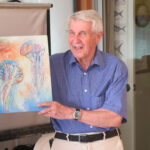


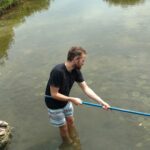
Abstracts
Mónica Medina
Opening Statement
Dietrich Hofmann
Description and illustration of sexual and asexual reproduction, strobilation, development and metamorphosis of planula larvae and planuloids.
Leslie Babonis
We aim to characterize the type and distribution of cnidocytes throughout development of the upside down jellyfish.
Analysis of gene expression of Cassiopea during strobilation suggests a developemntal mechanism deviating from what has been reported for the non-symbiotic scyphozoan Aurelia aurita . Cassiopea does not exhibit differential expression of key genes belonging to the retinoic acid pathway. This may implicate the symbiotic association in potentially altering developmental signaling in Cassiopea.
Elizabeth Vallen
We have been using immunofluorescence to analyze the cytoskeleton and extracellular matrix in symbiotic and aposymbiotic Aiptasia pallida . We have also recently constructed and begun to characterize a two-hybrid library to identify binding partners of Aiptasia proteins of interest.
Antonio Marques and Adrian James
Venom composition and evolution in cnidarians under a micro and macroevolutionary perspective.
Laura Miller
Understanding how the morphology of soft marine invertebrates affects the hydrodynamics of feeding and nutrient exchange is important for understanding this diversity of life and predicting how climate change will alter the distributions of these organisms. Bell pulsations of the upside down jellyfish Cassiopea spp. create feeding currents and may also enhance photosynthesis of symbiotic zooxanthellae. Similarly, some soft corals may also enhance photosynthesis through tentacle pulsations. Other soft invertebrates use active movements for efficient low speed cruising or alternatively for quick swimming bursts.
In this presentation, we use videography to quantify the movement of upside down jellyfish. We also use particle image velocimetry to reveal the flow fields these movements create. Numerical simulations of simplified models of jellyfish are used then to quantify and compare exchange mechanisms associated with pulsations. Numerical models allow us to isolate fundamental effects of different parameters as well as to extend the examination beyond experimental feasibility or even biological possibilities. In this way computational studies present an opportunity to explore fundamental physical limits on biological mechanisms.
Michael Abrams
Long term tracking of Cassiopea pulsing behavior reveals that they have the key characteristics of a sleep-like state: a quiescent state, homeostatic rebound, and sensory depression.
André Morandini and Edgar Gamero Mora
Historical background, valid species and boundaries, molecular data, and recent results.
Jane Wong
Most ecosystems on Earth are nutrient-limited, therefore resource competition is important for shaping succession and species community composition in many ecological habitats. Here, we test the hypothesis that Symbiodinium are selected on the basis of their ability to compete for nitrogen in hospite. We quantified resource acquisition & utilization of Symbiodinium by comparing kinetic parameters of Symbiodinium with the use of dual stable isotope labelling (13C & 15N) techniques.
Patricia Thomé
Recent experimental data on the metabolic dependence on glucose and glycerol, comparing the symbiotic animals Cassiopea xamachana and Exaiptasia pallida . Treatments of symbiotic vs bleached animals give strong evidence for the metabolic dependence on their symbionts and indicate important differences that caution against a generalisation for all symbiotic cnidarians.
Shelley Templeman
Presentation on research with Cassiopea maremetens in response to environmental pollutants. This includes metals, pesticides and the capacity of C. maremetens to bioaccumulate contaminants. I have also been developing some alternate measures of stress in the host and symbiont.
Tamar Goulet
Synthesis presentation
